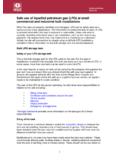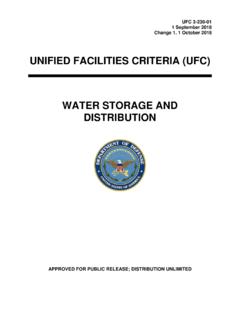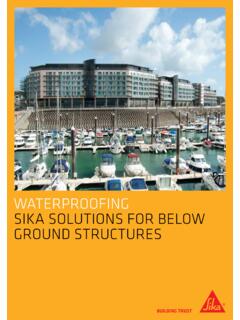Transcription of The Emergency Planning and Community Right-to-Know Act ...
1 Office of Land and November 2017 Emergency Management Office of Emergency Management Fact Sheet The Emergency Planning and Community Right-to-Know Act On December 4, 1984, methyl isocyanate, an extremely toxic chemical escaped from a Union Carbide chemical plant in Bhopal, India. Thousands died and many more were injured. Some suffered permanent disabilities. Approximately six months later, a similar incident occurred at the Institute, West Virginia. These two events raised concern about local preparedness for chemical emergencies and the availability of information on hazardous chemicals. In response to these concerns, Congress passed the Emergency Planning and Community Right-to-Know Act (EPCRA) in 1986. EPCRA establishes requirements for federal, state and local governments, Indian tribes, and industry regarding Emergency Planning and Community Right-to-Know reporting on hazardous and toxic chemicals.
2 The Community Right-to-Know provisions help increase public s knowledge and access to information on chemicals at individual facilities, their uses, and releases into the environment. States and communities, working with facilities, can use the information to improve chemical safety and protect public health and the environment. What Does EPCRA Cover? EPCRA has four major provisions: Emergency Planning (sections 301-303), Emergency release notification (section 304), Hazardous chemical storage reporting requirements (sections 311-312), and Toxic chemical release inventory (section 313). Information collected from these four requirements helps states and communities develop a broad perspective of chemical hazards for the entire Community , as well as for individual What Are SERCs, TERCS, and LEPCs? The Governor of each state designated a State Emergency Response Commission (SERC). The SERCs, in turn, designated about 3,500 local Emergency Planning districts and appointed Local Emergency Planning Committees (LEPCs) for each district.
3 The SERC supervises and coordinates the activities of the LEPC, establishes procedures for receiving and processing public requests for information collected under EPCRA, and reviews local Emergency response plans. The Chief Executive Office of the Tribe appoints the Tribal Emergency Response Commissions (TERCs). TERCs have the same responsibilities as the SERCs. The LEPC membership must include, at a minimum, local officials including police, fire, civil defense, public health, transportation, and environmental professionals, as well as representatives of facilities subject to the Emergency Planning requirements, Community groups, and the media. The LEPCs must develop an Emergency response plan, review it at least annually, and provide information about chemicals in the Community to citizens. EPCRA November 2017 Office of Emergency Management Fact Sheet 2 facilities. Regulations implementing EPCRA are codified in Title 40 of the Code of Federal Regulations, parts 350 to 372.
4 The chemicals covered by each of the sections are different, as are the quantities that trigger reporting. Table 1 summarizes the chemicals and thresholds. What Are Emergency Response Plans (Sections 301-303)? Emergency Response plans contain information that Community officials can use at the time of a chemical accident. Community Emergency response plans for chemical accidents were developed under section 303. LEPCs are required to update these plans annually. The plans must: Identify facilities and transportation routes of extremely hazardous substances; Describe Emergency response procedures, on and off site; Designate a Community coordinator and facility coordinator(s) to implement the plan; Outline Emergency notification procedures; Describe how to determine the probable affected area and population by releases; Describe local Emergency equipment and facilities and the persons responsible for them; Outline evacuation plans; Provide a training program for Emergency responders (including schedules); and, Provide methods and schedules for exercising Emergency response plans.
5 Planning activities of LEPCs and facilities initially focused on, but were not limited to, the 406 extremely hazardous substances (EHSs) listed by EPA in 1987 (now currently 355 chemicals). The list includes the threshold Planning quantities (minimum limits) for each substance. Any facility that has EHS at or above its threshold Planning quantity must notify the State Emergency Response Commission (SERC) or the Tribal Emergency Response Commission (TERC) and Local Emergency Planning Committee (LEPC) within 60 days after they first receive a shipment or produce the substance on site. What Are the Emergency Notification Requirements (Section 304)? Facilities must immediately notify the LEPC and the SERC or the TERC if there is a release into the environment of a hazardous substance that is equal to or exceeds the minimum reportable quantity set in the regulations. This requirement covers the 355 extremely hazardous substances, as well as the more than 700 hazardous substances subject to the Emergency notification requirements under CERCLA section 103(a)(40 CFR ).
6 Some chemicals are common to both lists. Initial notification can be made by telephone, radio, or in person. Emergency notification requirements involving transportation incidents can be met by dialing 911, or in the absence of a 911 Emergency number, calling the operator. This Emergency notification needs to include: The chemical name; An indication of whether it is an extremely hazardous substance; An estimate of the quantity released into the environment; The time and duration of the release; W hether the release occurred into air, water, and/or land; Any known or anticipated acute or chronic health risks associated with the Emergency , and where necessary, advice regarding medical attention for exposed individuals; Proper precautions, such as evacuation or sheltering in place; and, Name and telephone number of contact person. EPCRA November 2017 Office of Emergency Management Fact Sheet 3 A written follow-up notice must be submitted to the SERC or the TERC and LEPC as soon as practicable after the release.
7 The follow-up notice must update information included in the initial notice and provide information on actual response actions taken and advice regarding medical attention necessary for citizens exposed. What Are the Community Right-to-Know Requirements (Sections 311 and 312)? Under Occupational Safety and Health Administration (OSHA) regulations, employers must maintain a material safety data sheet (MSDS) for any hazardous chemicals stored or used in the work place. Approximately 500,000 products are required to have MSDSs. Section 311 requires facilities that have MSDSs for chemicals held above certain threshold quantities to submit either copies of their MSDSs or a list of these chemicals to the SERC or TERC, LEPC, and local fire department. If the facility owner or operator chooses to submit a list of chemicals, the list must include the chemical or common name of each substance and must identify the applicable hazard categories. These hazard categories are: Physical Hazards Flammable (gases, aerosols, liquids, or solids) Gas under pressure Explosive Self-heating Pyrophoric (liquid or solid) Oxidizer (liquid, solid, or gas) Organic peroxide Self-reactive In contact with water emits flammable gas Corrosive to metal Hazard Not Otherwise Classified (HNOC) If a list is submitted, the facility must submit a copy of the MSDSs for any chemical on the list upon request by the LEPC.
8 Facilities that start using a hazardous chemical or increase the quantity to exceed the thresholds must submit MSDSs or a list of MSDSs chemicals within three months after they become covered. Facilities must provide a revised MSDS to update the original MSDS or list if significant new information is discovered about the hazardous chemical. Facilities covered by section 311 must submit annually an Emergency and Hazardous Chemical Inventory Form to the LEPC, the SERC or the TERC, and the local fire department as required under section 312. Facilities provide either a Tier I or Tier II inventory form. Tier I inventory form include the following aggregate information for each applicable hazard category: An estimate (in ranges) of the maximum amount of hazardous chemicals for each category present at the facility at any time during the preceding calendar year; An estimate (in ranges) of the average daily amount of hazardous chemicals in each category; and, Health Hazards Carcinogenicity Acute toxicity (any route of exposure) Reproductive toxicity Skin Corrosion or Irritation Respiratory or Skin Sensitization Serious eye damage or eye irritation Specific target organ toxicity (single or repeated exposure) Germ cell mutagenicity Aspiration Hazard Hazard Not Otherwise Classified (HNOC) Office of Emergency Management 4 Fact Sheet EPCRA November 2017 The general location of hazardous chemicals in each category.
9 The Tier II inventory form contains basically the same information as the Tier I, but it must list the specific chemicals. Tier II inventory form provide the following information for each chemical: The chemical name or the common name as indicated on the MSDS; An estimate (in ranges) of the maximum amount of the chemical present at any time during the preceding calendar year and the average daily amount; A brief description of the manner of storage of the chemical; The location of the chemical at the facility; and An indication of whether the owner elects to withhold location information from disclosure to the public. Many states now require Tier II inventory form or the state equivalent including electronic reporting under state law. Section 312 information must be submitted on or before March 1 each year for information on chemicals present at the facility in the previous year. The information submitted under sections 311 and 312 is available to the public from LEPCs and SERCs or TERCs.
10 What is the Toxics Release Inventory (Section 313)? Section 313 of EPCRA established the Toxics Release Inventory. TRI tracks the management of certain toxic chemicals that pose a threat to human health and the environment. Facilities in different industry sectors must annually report how much of each chemical they managed through recycling, energy recovery, treatment and environmental releases. TRI reporting forms must be submitted to EPA and the appropriate state or tribe by July 1 of each year. These forms cover environmental releases and other management of toxic chemicals that occurred during the previous calendar year. The information submitted by facilities is compiled in the Toxics Release Inventory and made available to the public through the TRI website: TRI helps support informed decision-making by industry, government, non-governmental organizations and the public. TRI includes information about: On-site releases (including disposal) of toxic chemicals to air, surface water and land; On-site recycling, treatment and energy recovery associated with TRI chemicals; Off-site transfers of toxic chemicals from TRI facilities to other locations; Pollution prevention activities at facilities; Releases of lead, mercury, dioxin and other persistent, bioaccumulative and toxic (PBT) chemicals; and Facilities in a variety of industry sectors (including manufacturing, metal mining and electric power generation) and some federal facilities.














